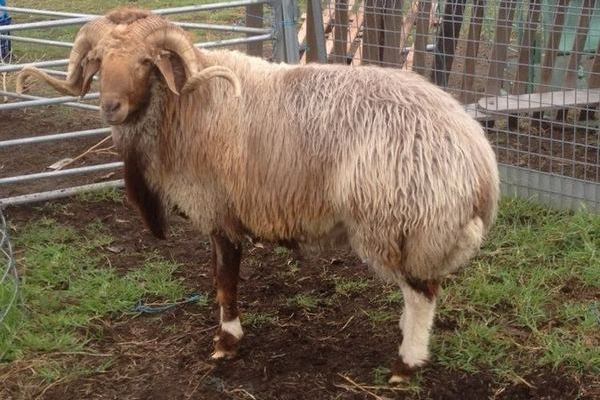
The Awassi is a local sheep breed in South-West Asia originated in the Syro-Arabian desert. Other local names can also be Ivesi, Baladi, Deiri, Syrian, Ausi, Nuami or Gezirieh. It is a fat-tailed type and is multi coloured: white with brown head and legs. The ears are long and drooping.
The Awassi is the most numerous and widespread breed of sheep in south-west Asia. It is the dominant type in Iraq, the most important sheep in the Syrian Arab Republic and the only indigenous breed of sheep in Lebanon, Jordan and Israel. In the north of the Kingdom of Saudi Arabia, it is bred under desert conditions. In Turkey, the Awassi makes up one percent of the ovine population; its breeding area is situated in southern Anatolia in a border strip along the main range habitat of the breed in the Syrian Arab Republic. The name of the Awassi is attributed to the El Awas tribe between the Tigris and Euphrates rivers. In literary Arabic, awas is the term for the red-and-white camel garb or for a white sheep (Hirsch, 1933). The name of the breed is also sometimes spelled Awasi, Aouasse, El Awas, Oussi, Ussy or Iwessi; in Turkey it is called Ivesi or Arab and in some parts of the Syrian Arab Republic, Nu’amieh or Shami, the latter being the Arabic name for Damascus.
Fat-tailed sheep have been bred in the breeding area of the Awassi for at least 5 000 years. In physical and functional properties, the Awassi seems to be very close to the prototype from which the fat-tailed sheep of Asia, Africa and Europe are derived. Many of these still show a close likeness to the Awassi. This holds true not only of the sheep of Cyprus and North Africa and several Turkish and Iranian breeds but animals similar to the Awassi are also encountered among the Ronderib Afrikander sheep of South Africa and the Mongolian sheep of eastern Asia. Fat-tailed breeds deviating from the Awassi in some physical or functional properties may owe their characteristics either to evolution in a different environment, specialized breeding aims or to cross-breeding.
The Awassi evolved as a nomadic sheep breed through centuries of natural and selective breeding to become the highest milk producing breed in the Middle East. The breed is of the Near Eastern Fat-tailed type. The average ewe has single lactions over 300 liters (650 pounds) per 210 day lactation and it is not uncommon for outstanding females to have 210 day lactations above 750 liters (1625 pounds). As a comparison the lactation of the average U.S. sheep breed is about 100-200 pounds per lactation.
The breed is calm around people, easy to work with and easily milked. When machine milked, they can be milked in 4-6 minutes. The breed also has the advantage of natural hardiness and grazing ability. The breed is well suited to a grazing production system as well as a confinement operation.